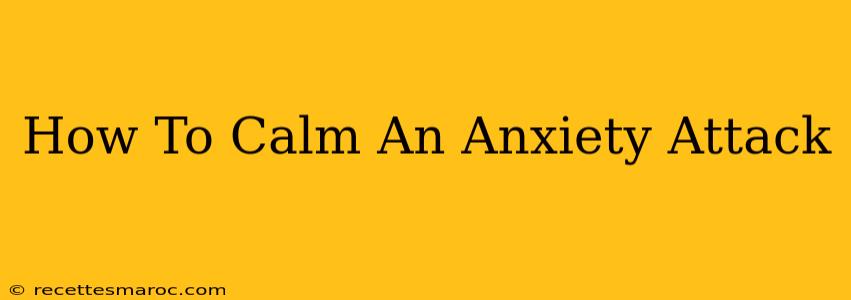Anxiety attacks can feel overwhelming and terrifying, but knowing how to manage them is empowering. This guide provides practical techniques to calm an anxiety attack and regain control. Remember, you're not alone, and these strategies can significantly help.
Understanding Anxiety Attacks
Before diving into coping mechanisms, it's helpful to understand what's happening during an anxiety attack. These intense episodes are characterized by a sudden surge of overwhelming fear or discomfort. Physical symptoms can include rapid heartbeat, shortness of breath, trembling, sweating, and dizziness. Understanding that these are physical manifestations of anxiety, not a sign of something seriously wrong, can be the first step towards calming down.
Immediate Actions to Calm an Anxiety Attack
When an attack hits, focus on these immediate steps:
1. Grounding Techniques:
- 5-4-3-2-1 Method: Name five things you can see, four things you can touch, three things you can hear, two things you can smell, and one thing you can taste. This anchors you to the present moment.
- Observe Your Surroundings: Pay close attention to details in your environment. Describe them mentally or out loud. What color is the wall? What objects are nearby? This helps shift your focus away from internal sensations.
2. Breathing Exercises:
- Diaphragmatic Breathing (Belly Breathing): Place one hand on your chest and the other on your stomach. Inhale deeply through your nose, feeling your stomach rise. Exhale slowly through your mouth, feeling your stomach fall. Focus on the rhythm of your breath. This slows your heart rate and reduces feelings of panic.
- Box Breathing: Inhale slowly to a count of four, hold for four, exhale slowly for four, and hold for four. Repeat several times.
3. Physical Actions:
- Move Your Body: Gentle movement like walking, stretching, or even just shaking out your hands and feet can release tension.
- Cold Water Splash: Splashing cold water on your face can provide a startling sensory input that interrupts the anxiety cycle.
4. Mental Strategies:
- Positive Self-Talk: Replace negative thoughts with positive affirmations. Remind yourself that this feeling is temporary and that you've overcome anxiety before.
- Visualization: Imagine a calm and peaceful place. Engage all your senses – what do you see, hear, smell, and feel?
Long-Term Strategies for Anxiety Management
While these immediate techniques are crucial during an attack, long-term strategies are essential for preventing future episodes:
1. Regular Exercise: Physical activity releases endorphins, which have mood-boosting effects. Aim for at least 30 minutes of moderate-intensity exercise most days of the week.
2. Mindfulness and Meditation: Practicing mindfulness helps you become more aware of your thoughts and feelings without judgment, allowing you to manage anxiety more effectively. Meditation can also significantly reduce anxiety levels over time.
3. Healthy Lifestyle: Prioritize sleep, nutrition, and limit caffeine and alcohol intake. These factors play a significant role in anxiety levels.
4. Professional Help: Don't hesitate to seek professional help from a therapist or counselor. They can provide guidance, support, and teach you coping strategies tailored to your specific needs. Consider therapies like Cognitive Behavioral Therapy (CBT) which is highly effective in treating anxiety.
When to Seek Emergency Care
While these techniques are helpful, sometimes an anxiety attack requires immediate medical attention. Seek emergency care if:
- You experience chest pain.
- You have difficulty breathing that doesn't improve with breathing exercises.
- You have thoughts of self-harm or suicide.
Remember: Anxiety attacks are treatable. By learning and practicing these techniques, you can gain control over your anxiety and live a more fulfilling life. Be patient with yourself, and celebrate your progress along the way.

